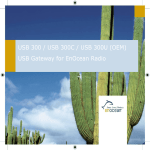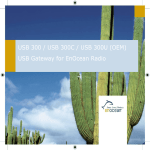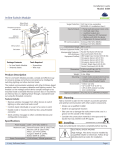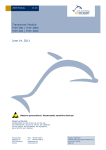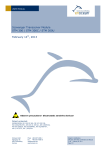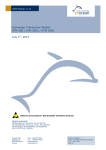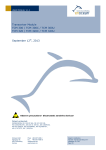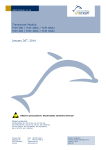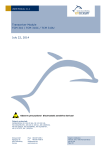Download USB 300(C) - Alpha Micro Components
Transcript
USER MANUAL USB 300(C) USB Stick Gateway for EnOcean Radio REVISION HISTORY The following major modifications and improvements have been made to the first version of this document: No 1.0 1.1 1.2 1.3 Major Changes LED description and protocol layers added Added max. ripple USB voltage, operation humidity, weight, contact cycles Added warnings Recommendation of extension cord for 315MHz Published by EnOcean GmbH, Kolpingring 18a, 82041 Oberhaching, Germany www.enocean.com, [email protected], phone +49 (89) 6734 6890 © EnOcean GmbH, All Rights Reserved EnOcean GmbH Kolpingring 18a 82041 Oberhaching Germany Phone +49.89.67 34 689-0 Fax +49.89.67 34 689-50 [email protected] www.enocean.com Subject to modification USB 300(C) User Manual October 31, 2011 Page 1/10 PRELIMINARY USER MANUAL USB 300(C) Important notes! This information describes the type of component and shall not be considered as assured characteristics. No responsibility is assumed for possible omissions or inaccuracies. Circuitry and specifications are subject to change without notice. For the latest product specifications, refer to the EnOcean website: http://www.enocean.com. As far as patents or other rights of third parties are concerned, liability is only assumed for modules, not for the described applications, processes and circuits. USB 300 and USB 300C are designed and produced as OEM products. They will be brought to market by local OEM manufacturers. They are not considered to be finished end products in terms of WEEE (electronic waste regulation). EnOcean will not be reliable for consequences of any HW or SW changes/modifications of the USB 300(C) done by the first marketer. Product warranty and support will be covered by the OEM. © 2011 EnOcean | www.enocean.com USB 300(C) User Manual | Page 2/10 PRELIMINARY USER MANUAL USB 300(C) Content 1. Introduction 2. Technical Data & Environmental Conditions 3. Block diagram and Feature List 4. First steps with USB 300 and DolphinView Basic 5. Warnings 6. Approvals © 2011 EnOcean | www.enocean.com USB 300(C) User Manual | Page 3/10 PRELIMINARY USER MANUAL USB 300(C) 1. Introduction USB 300 is a small USB stick which connects PC’s, consumer devices, DSL boxes and other USB master devices to the world of EnOcean based radio products. USB 300 is equipped with the TCM 300 transceiver module. It provides a bidirectional EnOcean radio with USB interface. Radio messages are sent transparently through the virtual serial interface in both directions from and to an externally connected USB host. USB 300 sends and receives EnOcean telegrams including signal strength. Additional control commands can be sent, e.g. configure repeater functionality. Further information about software features can be found within the TCM 310 user manual: http://www.enocean.com/en/enocean_modules/tcm-310 USB 300 is available for 868 MHz and 315 MHz: USB 300 (868Mhz): CE certified and conforms to the R&TTE EU directive on radio equipment USB 300C (315Mhz): conforms to the FCC / IC requirements © 2011 EnOcean | www.enocean.com USB 300(C) User Manual | Page 4/10 PRELIMINARY USER MANUAL USB 300(C) 2. Technical Data & Environmental Conditions Dimensions: OEM label size: Weight: 66 x 23 x 9mm (incl. transport cap 70 x 23 x 9mm) 39 x 12mm 12g Operation temperature: Storage temperature: Operation humidity: Storage humidity: USB contact durability: 0°C -25°C 0% 0% 500 cycles +40°C +65°C 80% r.h. 93% r.h. Max. ripple USB voltage: 50 mVpp 868 MHz: Chip antenna (R&TTE EN 300 220) 315 MHz: Whip antenna (FCC CFR-47 Part15) CE: yes RoHS: yes Housing: OEM Label PCB: Rx/Tx LED (optional) TCM 310(C) Power LED (optional) © 2011 EnOcean | www.enocean.com USB 300(C) User Manual | Page 5/10 PRELIMINARY USER MANUAL USB 300(C) 3. Block diagram and Feature List Block diagram: Host Sensor/ Actuator USB 300 USB Interface FTDI Virtual COM Port USB USB<->UART FTDI FT232R UART TCM 310(C) EnOcean Gateway Controller Wireless EnOcean Radio Protocol layers: Host Application Sensor/Actuator Application EnOcean Equipment Profile (see 4.) EnOcean Equipment Profile (see 4.) EnOcean Serial Protocol 3 (see 3.) FTDI Virtual COM Port (see 1.,2.) UART 57,6kBit, 8N1 USB (see 1.,2.) EnOcean Radio 868MHz / 315MHz 125kBit/s Documentation of protocols and profiles: 1. Plug’n play device drivers from FTDI for Microsoft Windows, Linux and Apple Mac OS: http://www.ftdichip.com/FTDrivers.htm 2. Other host platforms can use or adapt available C-source code for Linux OS from FTDI Website: http://www.ftdichip.com/Drivers/VCP.htm 3. Commands and data communication is done via EnOcean Serial Protocol 3: http://www.enocean.com/en/knowledge-base/ TCM 310 specific features and commands: http://www.enocean.com/en/enocean_modules/tcm-310/ 4. EnOcean radio profiles are defined within the EnOcean Equipment Profile description: http://www.enocean-alliance.org/ © 2011 EnOcean | www.enocean.com USB 300(C) User Manual | Page 6/10 PRELIMINARY USER MANUAL USB 300(C) Additional features: USB 300 can be used as repeater of EnOcean telegrams; this will expand the range of radio devices. For details see ESP3 command description of CO_WR_REPEATER within the ESP3 description: http://www.enocean.com/en/knowledge-base/ USB 300 can filter EnOcean telegrams; this can avoid heavy data load for the host system. For details see ESP3 command description of CO_WR_FILTER_ADD within the ESP3 description: http://www.enocean.com/en/knowledge-base/ USB 300 supports remote management of self-powered radio nodes. For details see TCM 310 and ESP3 command description of REMOTE_MAN_COMMAND within the ESP3 description: http://www.enocean.com/en/knowledge-base/ USB 300 supports smart acknowledge of self-powered radio nodes. This feature enables bidirectional communication for self-powered radio nodes. For details see TCM 310 and ESP3 command description of SMART_ACK_COMMAND within the ESP3 description: http://www.enocean.com/en/knowledge-base/ Hint: For advanced analysis and protocol debugging we recommend EnOcean Developer Kit EDK 300 with DolphinView Advanced and Sniffer Software on TCM 3x0. © 2011 EnOcean | www.enocean.com USB 300(C) User Manual | Page 7/10 PRELIMINARY USER MANUAL USB 300(C) 4. First steps with USB 300 and DolphinView Basic 1. Register and download DolphinView Basic from: http://www.enocean.com/en/download/ 2. Install DolphinView Basic 3. Plug USB 300 into free USB port the PC. Hint for USB 300C (315 MHz): EnOcean recommends the usage of USB extension cord (>=30cm) to reduce noise level of PCs. 4. Start DolphinView Basic and connect to COM port 5. Press self-powered switch or learn button of sensor, DolphinView Basic will display telegram 6. Following example illustrates the visualization of several sensor nodes: © 2011 EnOcean | www.enocean.com USB 300(C) User Manual | Page 8/10 PRELIMINARY USER MANUAL USB 300(C) 5. Additional hints USB 300(C) should not be exposed to rapid temperature changes shortly before or during operation. Condensation of moisture might damage the device. USB 300(C) is not intended to be used in rough environment with heavy vibrations or mechanical shocks. The USB front cap is used as handling protection during delivery. Some PCs, notebooks or set top boxes might emit electromagnetic noise in the frequency area used by USB 300 (868MHz) or USB 300C (315MHz). This could lead to reduced radio range and/or reduced RSSI level. In most cases a shielded USB cable between this host devices and USB 300(C) will reduce this effect. Installation location of radio nodes should be carefully planned. Application note AN001 at http://www.enocean.com/en/application-notes/ will explain basic rules. USB 300 configurations done by ESP3 commands (e.g. repeater on, filter, maturity time) will be lost in case of power off. If you need these configurations permanent, make sure USB 300 has continues power or resend commands after power down. For advanced analysis and protocol debugging we recommend EnOcean Developer Kit EDK 300 with DolphinView Advanced and Sniffer Software on TCM 3x0. © 2011 EnOcean | www.enocean.com USB 300(C) User Manual | Page 9/10 PRELIMINARY USER MANUAL USB 300(C) 6. Approvals 6.1 CE and R&TTE conformity (European Union) USB 300 (868Mhz) conforms to CE and to the R&TTE EU directive on radio equipment. The device conforms to the European and national requirements of electromagnetic compatibility. The conformity has been proven and the according documentation has been deposited at EnOcean. The device can be operated without notification and free of charge in the area of the European Union and in Switzerland. Labelling according to CE and WEE is done by the OEM manufacturer which will bring the product to the market. 6.2 FCC (US) USB 300C (315Mhz) is based on the EnOcean STM 300C radio module. This hardware has a limited modular approval according to FCC. The conformity has been proven and the according documentation has been deposited at EnOcean. Contains FCC ID: SZV-STM300C The enclosed device complies with Part 15 of the FCC Rules. Operation is subject to the following two conditions: (i.) this device may not cause harmful interference and (ii.) this device must accept any interference received, including interference that may cause undesired operation. 6.3 IC (Canada) USB 300C (315Mhz) is based on the EnOcean STM 300C radio module. This hardware has a limited modular approval according to FCC. The conformity has been proven and the according documentation has been deposited at EnOcean. Contains IC: 5713A-STM300C The enclosed device complies with Part 15 of the FCC Rules. Operation is subject to the following two conditions: (i.) this device may not cause harmful interference and (ii.) this device must accept any interference received, including interference that may cause undesired operation. 6.3 RoHS EnOcean certifies that to its knowledge, USB 300 and USB 300C, are RoHS compliant, conforming to the requirements of “Directive 2002/95/EC of the European Parliament and of the Council of 27 January 2003 on the restriction of the use of certain hazardous substances in electrical and electronic equipment.” This declaration is based on EnOcean’s current understanding of the RoHS Directive and information provided through supplier material declarations pertinent to the ingredients and materials comprising EnOcean product. © 2011 EnOcean | www.enocean.com USB 300(C) User Manual | Page 10/10










